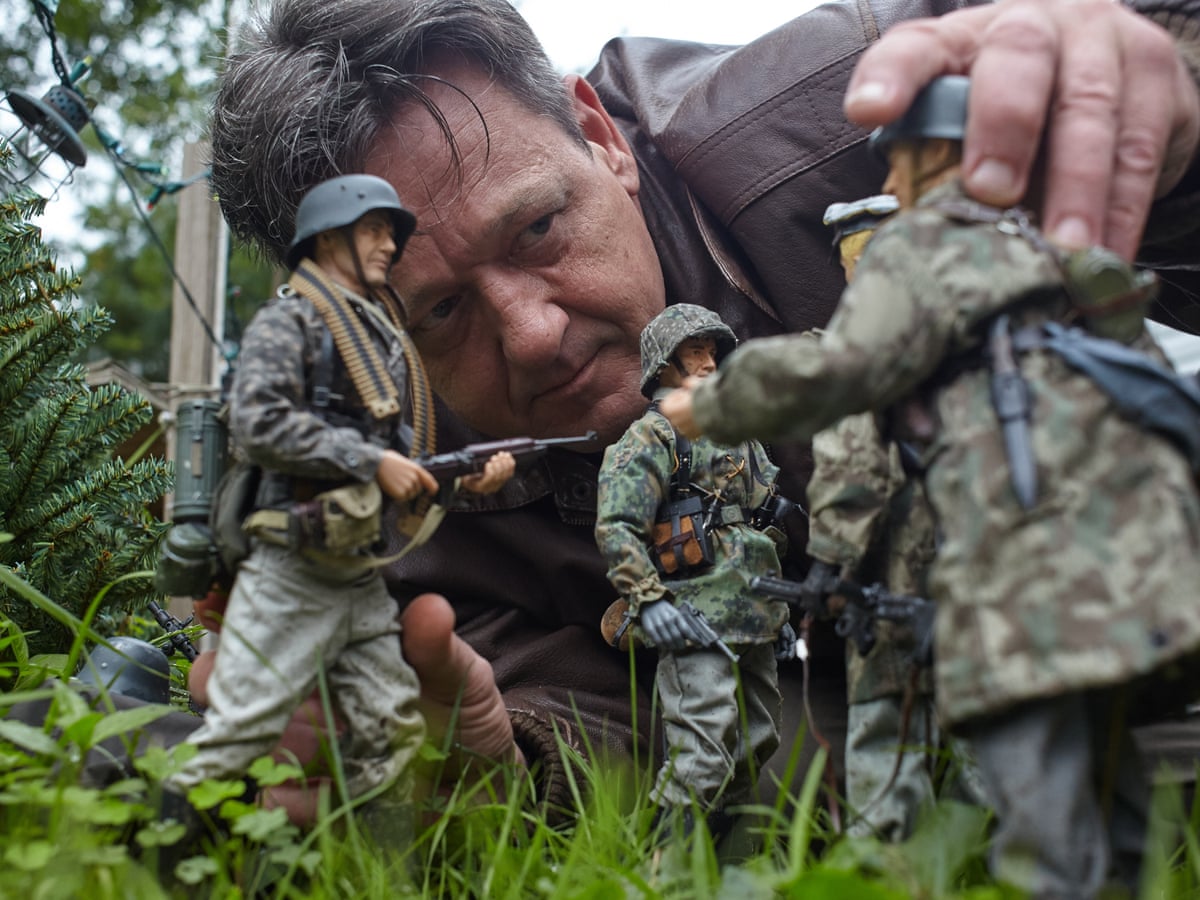By Chlotrudis Independent Film Society
Rating: 5 cats
Director: Jeffrey Malmberg

Country: united_states
Year: 2010
Running time: 83
IMDB: http://www.imdb.com/title/tt1504300/
Jason says: “Documentaries about artists and art are frequently disappointing. Filmmakers try their best, but as artists themselves they can make intuitive leaps between their subject and his or her work that is not obvious to a general audience, who hear vague words and see abstractions. That’s not the case with MARWENOL; the artist and artwork are not just inseparable, but unusually accessible.
“On 18 April 2010, Mark Hogancamp was attacked outside a bar in his hometown of Kingston, New York by five young men, and sustained tremendous brain damage – he had to relearn how to walk, talk, and even feed himself; he not only lost his memory, but a great deal of control over his anger and ability to concentrate. Naturally, he had a wholly inadequate rehabilitation program, and when released from the hospital, was more or less left ot his own devices. What he came up with was ‘Marwencol,’ a 1:6-scale Belgian village, circa World War II, that he built in his back yard and populated with army and fashion dolls. One was named after himself; others after friends and family. He would build an intricate narrative around these characters, and photograph them. Eventually, a professional photographer, David Naugle, would see his work, and forward it to Esopus magazine editor Tod Lippy, leading to a gallery show in Soho.
“Even without context, Hogancamp’s work is striking; he has a natural eye for composition (although, before he had a digital camera, it took long rounds of trial and error to learn the craft of photography), he can use a still photograph to tell a story, and an eye for detail. His photographs flit across the uncanny valley without being trapped in the middle; though clearly made of toys and sometimes out of scale to the environment, the scenes often seem real. I would (and will) happily purchase a book featuring Mark’s photos.
“But that’s only one surface layer; while all artists take inspiration from their lives, it soon becomes very clear that for Mark, this therapy is not just about exercising his fine motor skills and the visual centers of his brain. His attackers become Nazis in a scenario that re-enacts his beating; his revenge is bloody. What filmmaker Jeff Malmberg shows us is not just catharsis, though – Mark’s interaction with the world he creates is a highly complex, sometimes uncomfortable thing. Though Malmberg presents Mark sympathetically, he is also very clearly damaged; his Marwencol fantasies sometimes lead to strained real-world interactions as he gives both worlds equal weight. Malmberg doesn’t gloss over that, though he never pushes it so that we see Mark as some sort of pitiable freak.
“That’s an accomplishment, considering that one of the recurring themes is that Mark has more connection to the Barbie-doll girlfriends he invents for soldier-Mark than, say, his ex-wife because of his faulty memory. Malmberg gets us into Mark’s world on occasion, spending some time relating the Marwencol stories but spending most of his time in the real world, talking with his friends, family, and neighbors. As noteworthy as his art is, the story of a man rediscovering and recreating himself is potentially more so, and by the end of the movie things have come intriguingly full-circle: Things we learn late in the movie impact what happened in the start, and Mark’s latest additions to Marwencol’s mythology offer food for thought while pulling us another level down the rabbit hole.
“And that’s as it should be. As Mark puts it, ‘People see art in what I film… It’s still my therapy, no matter how much art people see.’ MARWENCOL is fantastic at showing it as both, a case where art and artist truly cannot be separated. 5 cats
“Seen 27 April 2010 at the Institute for Contemporary Art (Independent Film Festival of Boston)”
Chris says: “A decade ago in Kingston, New York, Mark Hogencamp was brutally beaten up by five young men in a parking lot. He survived, but with severe physical and even worse brain damage. After a few years of hospitalization that left him mostly healed but still under a lot of psychological distress, his insurance ran out, forcing him to live on his own. Hogencamp’s pre-attack diaries reveal he was a talented sketch artist, but his now-shaky hand prevents him from being able to draw. As a form of self-therapy, he begins to construct dioramas around his trailer home and yard, using the older, larger G. I. Joe and Barbie dolls as models. With time, he constructs his own elaborate town, a Belgian village during World War II whose name gives this documentary its title. If it all sounds incredibly kitschy, it’s not—Hogencamp is completely serious about his creations. He gives the dolls the names of people from his life—the guys who beat him up are rendered as Nazi soldiers, and he utilizes them in oft-gruesome scenarios to work through his trauma. He also takes artful, arresting photographs of the scenes he’s created, and they’re good enough to eventually lead to his own New York City gallery show. Throughout, Hogencamp appears before us as sweet, sad and more than a little fragile, but details about his past gradually surface that considerably deepen and complicate how we see him (particularly the shocking reason why he was beaten up, revealed midway through and too important to give away here). Jeff Malmberg’s film beautifully, profoundly illustrates the process of art-as-therapy, but it’s just as much a riveting account of a fascinating subject. 5 cats”
